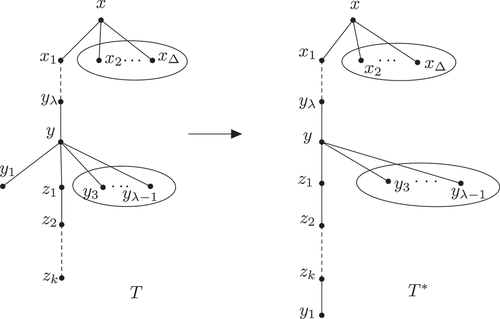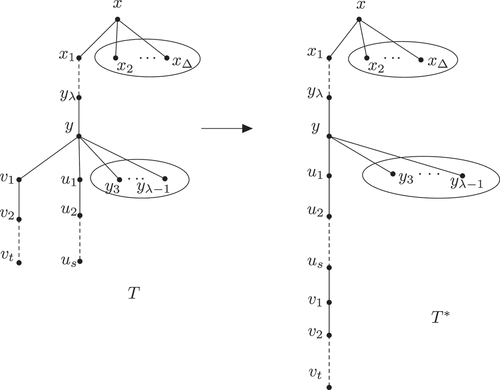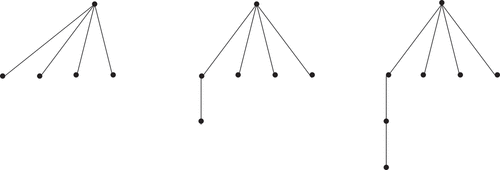 ?Mathematical formulae have been encoded as MathML and are displayed in this HTML version using MathJax in order to improve their display. Uncheck the box to turn MathJax off. This feature requires Javascript. Click on a formula to zoom.
?Mathematical formulae have been encoded as MathML and are displayed in this HTML version using MathJax in order to improve their display. Uncheck the box to turn MathJax off. This feature requires Javascript. Click on a formula to zoom.ABSTRACT
The Sombor index as a new degree-based topological index was first put forward in 2021 by Gutman. Recently, Kulli introduced a variant of the Sombor index called first irregularity Sombor index. The first irregularity Sombor index of a graph G, denoted by , is defined as the sum of weights
of all edges vw of E(G), where
denotes the degree of a node v in G. In this paper we show that for any tree T of order n with maximum degree Δ,
We also characterize the extremal trees.
MATHEMATICS SUBJECT CLASSIFICATION:
1. Introduction
Let G be a simple graph of order n. The node and edge sets of G are shown by V(G) and E(G), respectively. For , the open neighborhood of w in G,
, is the set
. The degree of a node
is
. We consider
as the maximum degree of G. The distance between two nodes of G is the length of any shortest path in G connecting them.
In the last decade, some variants of topological indices introduced, such as multiplicative Zagreb indices (Gutman, Citation2011; Xu & Hua, Citation2012), irregularity (Ali et al., Citation2021; Azari et al., Citation2023; Ma et al., Citation2019; Yousaf et al., Citation2020; Zhou & Luo, Citation2008), Zagreb coindices (Ashrafi et al., Citation2010; Došlić, Citation2008; Gutman et al., Citation2015; Rasi et al., Citation2017), Lanzhou index (Dehgardi & Liu, Citation2021; Vukičević et al., Citation2018), eccentricity index (Akhter & Farooq, Citation2020; Farooq et al., Citation2022, Citation2023), etc. One of such variants is the Sombor index which was introduced by Gutman (Gutman, Citation2021) as:
Recently, some novel variants of Sombor index introduced, such as the reduced Sombor index, multiplicative Sombor index, KG-Sombor index, first irregularity Sombor index, etc. For more information about variants of the Sombor see (Cruz & Rada, Citation2021; Das & Shang, Citation2021; Das et al., Citation2021; Došlić et al., Citation2021; Gutman et al., Citation2022; Kosari et al., Citation2023; Kulli, Citation2021; Kulli & Gutman, Citation2021; Liu et al., Citation2021; Ramane et al., Citation2023; Shang, Citation2022) and the references therein.
In this paper we focus on first irregularity Sombor index. The first irregularity Sombor index defined as:
We obtain a lower bound on the first irregularity Sombor index of trees with given their nodes number and maximum degree. Finally, we determine the extremal trees achieve this bound.
2. Trees with minimum first irregularity Sombor index
A tree is a connected acyclic graph. A node of degree one of a tree is called a leaf. A node adjacent to a leaf and a node adjacent to at least two leaves are called support node and strong support node respectively. A rooted tree is a tree with a special node chosen as the root of the tree.
A starlike is a tree with one node of degree at least three. The node with degree at least three in a starlike is called the center. The leg of a starlike is a path from the center node to a leaf. A star is a starlike with all legs of length one. Also the path is a starlike with one or two leg.
In this section, T denote a tree rooted at x such that . Also,
, is the set of all trees with n nodes and maximum degree Δ.
Lemma 1.
If contains a node of degree greater than two except x, then there is
such that
.
Proof.
Assume that y is a node with maximum distance from x such that . Let
such that yλ lies on the path from y to x and
. Consider the following cases.
Case 1. y is a strong support node of T.
Let y1 and y2 be two leaves. Denote by the tree achieved by attaching the edge
to
(see Figure ). Hence
If , then
Now let . Then
Since , then we have
Case 2. y is a support node of T.
We can assume that, y1 be a leaf and be a path in T such that
and
. Let
be the tree derived from
by adding the path
(see Figure ). then
If , then
Now let . Then
Case 3. All nodes adjacent to y are of degree at least two.
Let and
be two paths in T such that
,
and
. Assume
be the tree derived from
by adding the path
(see Figure ). Then
If , then
Now let . Then
This completes the proof.
Lemma 2.
Let be a starlike with
. If T has at least two legs of length greater than one, then there exists a starlike
such that
.
Proof.
Let T be a starlike with center x and . Assume that
,
,
be two legs of length greater than one in T such that
and
. Suppose that
be the tree derived from
by attaching the path
. Hence
If t = 2, then
and if , then
Therefore
This completes the proof.
Now we ready to prove the main theorem of this paper.
Theorem 3.
For any tree of order
,
The equality holds if and only if T is a starlike with at most one leg of length greater than one.
Proof.
Let be a tree with
for every
. Assume x be a root node of Tʹ such that
. If
, then T is a path and
as desired. Let . By the selection of Tʹ and Lemma 1, Tʹ is a starlike with center x. By Lemma 2, Tʹ has at most one leg of length greater than one. If Tʹ be a star, then
. Now let Tʹ have only one leg of length greater than one. Thus
This completes the proof.
See Figure , three trees of orders , maximum degree 4 and with minimum first irregularity Sombor index.
Author contribution statement
Nasrin Dehgardi: Conceptualization; Investigation; Methodology; Validation; Writing original draft. Yilun Shang: Visualization; Investigation; Validation; Resources; Funding acquisition; Writing review and editing.
First_ISOI_Dehgardi_Shang.tex
Download Latex File (32.9 KB)Disclosure statement
No potential conflict of interest was reported by the author(s).
Data availability statement
The paper does not include or use any datasets.
Supplementary material
Supplemental data for this article can be accessed online at https://doi.org/10.1080/27684830.2023.2291933
References
- Akhter, S., & Farooq, R. (2020). Eccentric adjacency index of graphs with a given number of cut edges. Bulletin of the Malaysian Mathematical Sciences Society, 43(3), 2509–2522. https://doi.org/10.1007/s40840-019-00820-x
- Ali, A., Chartrand, G., & Zhang, P. (2021). Irregularity in graphs. Springer.
- Ashrafi, A., Došlić, T., & Hamzeh, A. (2010). The Zagreb coindices of graph operations. Discrete Applied Mathematics, 158(15), 1571–1578. https://doi.org/10.1016/j.dam.2010.05.017
- Azari, M., Dehgardi, N., & Došlić, T. (2023). Lower bounds on the irregularity of trees and unicyclic graphs. Discrete Applied Mathematics, 324, 136–144. https://doi.org/10.1016/j.dam.2022.09.022
- Cruz, R., & Rada, J. (2021). Extremal values of the Sombor index in unicyclic and bicyclic graphs. Journal of Mathematical Chemistry, 59(4), 1098–1116. https://doi.org/10.1007/s10910-021-01232-8
- Das, K. C., Cevik, A. S., Cangul, I. N., & Shang, Y. (2021). On Sombor index. Symmetry, 13(1), 140. https://doi.org/10.3390/sym13010140
- Das, K. C., & Shang, Y. (2021). Some extremal graphs with respect to Sombor index. Mathematics, 9(11), 1202. https://doi.org/10.3390/math9111202
- Dehgardi, N., & Liu, J.-B. (2021). Lanzhou index of trees with fixed maximum degree. MATCH Communications in Mathematical and in Computer Chemistry, 86(1), 3–10.
- Došlić, T. (2008). Vertex-weighted Wiener polynomials for composite graphs. Ars Mathematica Contemporanea, 1(1), 66–80. https://doi.org/10.26493/1855-3974.15.895
- Došlić, T., Réti, T., & Ali, A. (2021). On the structure of graphs with integer Sombor indices. Discrete Mathematics Letters, 7, 1–4. https://doi.org/10.47443/dml.2021.0012
- Farooq, R., Akhter, S., & Rada, J. (2022). Total eccentricity index of trees with fixed pendent vertices and trees with fixed diameter. Japan Journal of Industrial and Applied Mathematics, 39(1), 443–465. https://doi.org/10.1007/s13160-021-00494-8
- Farooq, R., Malik, M. A., & Rada, J. (2023). Extremal graphs with respect to the total-eccentricity index. Asian-European Journal of Mathematics, 16(8), 2350138. https://doi.org/10.1142/S1793557123501383
- Gutman, I. (2011). Multiplicative Zagreb indices of trees. Bulletin of International Mathematical Virtual Institute, 1, 13–19.
- Gutman, I. (2021). Geometric approach to degree-based topological indices: Sombor indices. MATCH Communications in Mathematical and in Computer Chemistry, 86(1), 11–16.
- Gutman, I., Furtula, B., Vukičević, K., & Popivoda, G. (2015). On Zagreb indices and coindices. MATCH Communications in Mathematical and in Computer Chemistry, 74(1), 5–16.
- Gutman, I., Redžepović, I., & Kulli, R. K. (2022). KG-Sombor index of Kragujevac trees. Open Journal of Discrete Applied Mathematics, 5(1), 25–28. https://doi.org/10.30538/psrp-odam2022.0067
- Kosari, S., Dehgardi, N., & Khan, A. (2023). Lower bound on the KG-Sombor index, commun. Communications in Combinatorics and Optimization, 8(4), 751–757. https://doi.org/10.22049/CCO.2023.28666.1662
- Kulli, V. R. (2021). New irregularity Sombor indices and new Adriatic (a, b)-KA indices of certain chemical drugs. International Journal of Mathematics Trends and Technology, 67(9), 105–113. https://doi.org/10.14445/22315373/IJMTT-V67I9P512
- Kulli, V. R., & Gutman, I. (2021). Computation of Sombor indices of certain networks. International Journal of Applied Chemistry, 8(1), 1–5. https://doi.org/10.14445/23939133/IJAC-V8I1P101
- Liu, H., You, L., Tang, Z., & Liu, J. B. (2021). On the reduced Sombor index and its applications. MATCH Communications in Mathematical and in Computer Chemistry, 86(3), 729–753.
- Ma, Y., Cao, S., Shi, Y., Dehmer, M., & Xia, C. (2019). Nordhaus-Gaddum type results for graph irregularities. Applied Mathematics and Computation, 343, 268–272. https://doi.org/10.1016/j.amc.2018.09.057
- Ramane, H. S., Gutman, I., Bhajantri, K., & Kitturmath, D. V. (2023). Sombor index of some graph transformations, commun. Communications in Combinatorics and Optimization, 8(1), 193–205. https://doi.org/10.22049/CCO.2021.27484.1272
- Rasi, R., Sheikholeslami, S. M., & Behmaram, A. (2017). An upper bound on the first Zagreb index and coindex in trees. The Iranian Journal of Mathematical Chemistry (IJMC), 8(1), 71–82. https://doi.org/10.22052/ijmc.2017.42995
- Shang, Y. (2022). Sombor index and degree-related properties of simplicial networks. Applied Mathematics and Computation, 419, 126881. https://doi.org/10.1016/j.amc.2021.126881
- Vukičević, D., Li, Q., Sedlar, J., & Došlić, T. (2018). Lanzhou Index. MATCH Communications in Mathematical and in Computer Chemistry, 80(3), 863–876.
- Xu, K., & Hua, H. (2012). A unified approach to extremal multiplicative Zagreb indices for trees, unicyclic and bicyclic graphs. MATCH Communications in Mathematical and in Computer Chemistry, 68(1), 241–256.
- Yousaf, S., Bhatti, A. A., & Ali, A. (2020). A note on the modified Albertson index. Discrete Dynamics in Nature & Society, 2020, 1–4. https://doi.org/10.1155/2020/3976274
- Zhou, B., & Luo, W. (2008). On irregularity of graphs. Ars Combinatoria, 88, 55–64.




